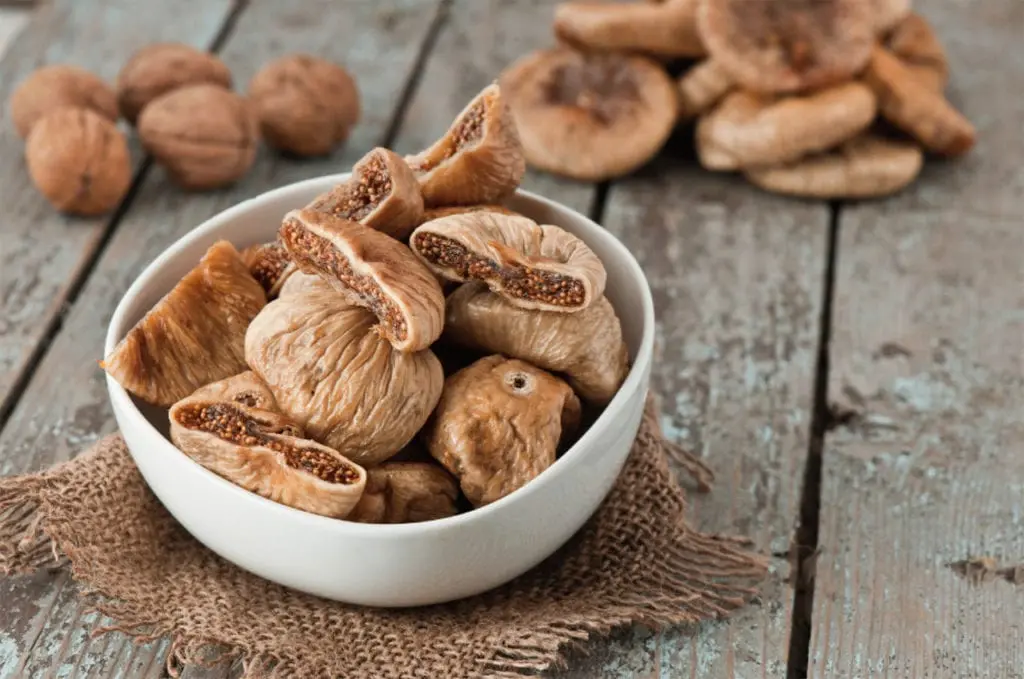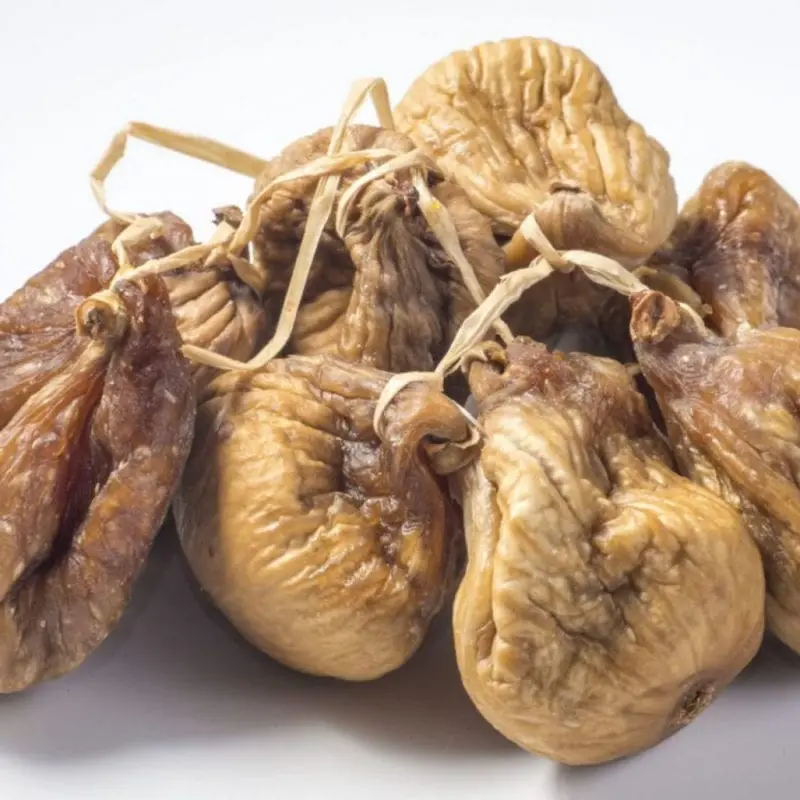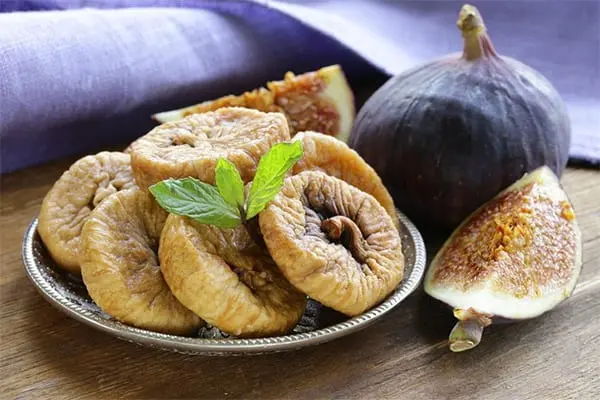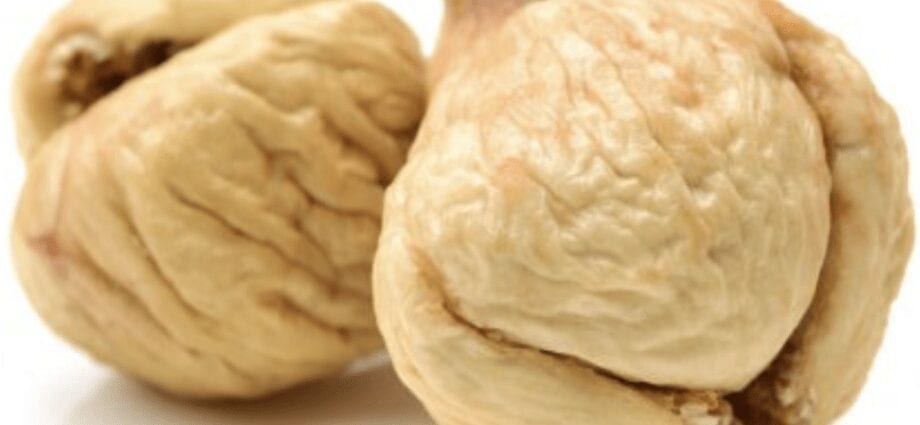Contents
Description of Dried figs
The tree from which the fruit is harvested for the production of dried figs is the fig tree. The fig tree is deciduous and can reach a height of 7‒10 meters. Trees grow in dry, sunny areas with fresh and deep soils. They also settle in rocky areas and can survive in less fertile soils.
Fig trees live up to 100 years and have long, winding branches that sometimes exceed the height of the tree itself. The homeland of figs is the Middle East and Western Asia. Fig trees are now cultivated all over the world, including Asia and North America.
Figs grow up to a size of 3-5 centimeters, with an impressive weight of up to 50-70 grams. As they mature, green figs turn either purple or brown. Figs have a unique taste. The sweet soft texture and crunchy seeds create an unusual and interesting combination. The taste of the fruit also depends on its color.

In nature, there are a large number of varieties of figs: oval or pear-shaped, white, green, red, yellow, purple and even black. Fresh figs are available from June to September, while dried figs are available all year round.
Fig berries are pear-shaped or heart-shaped, with a light greenish or deep purple hue and a pink or red flesh. White figs are often larger than dark figs, they look spectacular and have a subtler taste.
At the same time, nondescript, small dark berries usually have an explosive, sweet, concentrated flavor. Unripe fruits contain a pungent milky juice and are inedible. And only barely cracked berries taken from a branch are most tasty.
Fig varieties

- “Crimean Black” – an early variety with large sweet berries in a thin dark skin was bred by scientists of the Nikitsky Botanical Garden.
- Early Gray is an early variety that bears fruit twice a season, with medium-sized fruits with light brown or purple skin and extremely tasty pulp.
- “Dalmatian” or “Turkish white” self-pollinating variety, which is considered one of the best among the early. The fruits are large, weighing up to 180 g.
- Kadota, or Adriatic, is a white variety bred and popular in the United States. Frost-resistant (withstands temperatures up to minus 10 ° C), medium late, transportable.
Brunswick is an early variety with fruits weighing up to 200 g and can withstand temperatures as low as minus 27 ° C. Light fruits have a purple barrel and a raspberry-colored flesh.
Composition and calorie content
Dried figs contain beta-carotene and many B vitamins. Dried fruits are also rich in protein, mineral salts of potassium, magnesium and iron. Also in the fruits of dried figs there is fiber, pectins. But why do doctors recommend their patients to consume dried figs? This product has a lot of useful properties.
- Calorie value 257 kcal
- Proteins 3.1 g
- Fat 0.8 g
- Carbohydrates 57.9 g
Dried Figs: Benefits
Figs are high in natural sugars, minerals and soluble fiber. The mineral composition includes potassium, calcium, magnesium, iron and copper and is a good source of antioxidants, vitamins A and K, which contribute to health and wellness.

Figs are a storehouse of beneficial phytonutrients, antioxidants and vitamins. Dried figs are a source of natural sugars and soluble fiber. They are rich in fiber, potassium, iron, magnesium, phosphorus, manganese, calcium, chlorine, sodium, vitamin B6 and K, Retinol (vitamin A), thiamine (vitamin B1), riboflavin (vitamin B2). The use of figs is recommended for asthma, cough, bronchitis, sexual dysfunctions, constipation, gastrointestinal disorders.
Dried figs have a high glycemic index – 62, and fresh ones – 55. Therefore, eating dried figs quickly raises blood sugar levels. On the other hand, the presence of potassium helps to reduce spikes in sugar. Therefore, people with type 2 diabetes need to be very careful when eating figs.
It should be noted that not only dried, but also fresh figs contain a large amount of natural sugar – fructose, which, if consumed in excess, may worsen the state of health. Therefore, dried figs are great as a natural and healthy treat for children and adults, but they are recommended to be consumed in moderation.
Sweet foods, including figs, quickly fill the body with energy. Therefore, it is better to include them in the diet in the morning so that this energy is used up throughout the day.
Dried figs have many other health benefits. Let’s take a look at some of them.
Dried figs and women’s health

In many eastern countries, dried figs have traditionally been served as a dessert to women. Since ancient times, people have noticed that they help relieve physical ailment during menstruation.
Also, the use of dried fruits contributed to the normalization of mental balance during this period. What else is dried figs useful for women?
Modern doctors recommend using it for those who are planning to become pregnant or expecting a baby. This recommendation is based on the fact that fig fruit contains a large amount of folic acid. This substance helps preserve the integrity of the placenta and has a beneficial effect on the intrauterine development of the unborn baby.
Modern research has shown that it is beneficial for women to include dried figs in their diet during the second and third trimester of pregnancy. It turned out that their contractions are easier, and the total time of labor is reduced by one hour. In addition, in women giving birth for the first time, erection is faster and easier.
Dried figs for men
There is a widespread legend that dried figs have a positive effect on potency. But, unfortunately, there are no magic products to get rid of this problem. However, dried figs are as beneficial for men as they are for women.
A large amount of vitamins and minerals helps to maintain health for people of any age and gender.
Figs for children

Pediatricians do not recommend including dried fruit in the menu of children under one year old. After reaching this age, you can give one dried fruit to the child, but it is better to divide it into small portions.
The large amounts of fast carbohydrates found in any dried fruit can harm your baby’s health. Therefore, if you have such an opportunity, choose fresh ripe fruits for him. How else does dried figs affect the health of babies?
Benefits for children can be indicated by the following points: Dried figs can help with constipation. But if the crushed dried fruits did not bring the expected result, then you should use medications. Use dried fruit for desserts. The natural sweetness of these foods will help eliminate sugar and candy from your baby’s diet.
Dried figs contraindications
The calorie content of raw figs is 74 kcal per 100 g, and dried figs – 257 kcal, therefore, in diabetes mellitus, figs (especially dried ones) should be excluded from the constant diet.
Also, figs are not recommended to eat if there are inflammatory processes in the gastrointestinal tract and the genitourinary system. Due to the presence of oxalic acid, you need to be careful and people who have a tendency to form stones.
It is also not recommended for hypotonic patients to eat figs, as they can provoke a sharp drop in blood pressure.











molt complerta la informaciò, no obstant no he pogut solucionar el dubte de si les figues seques enfarinades s’han de rentar. Fins ara, me les menjaba sense rentar.